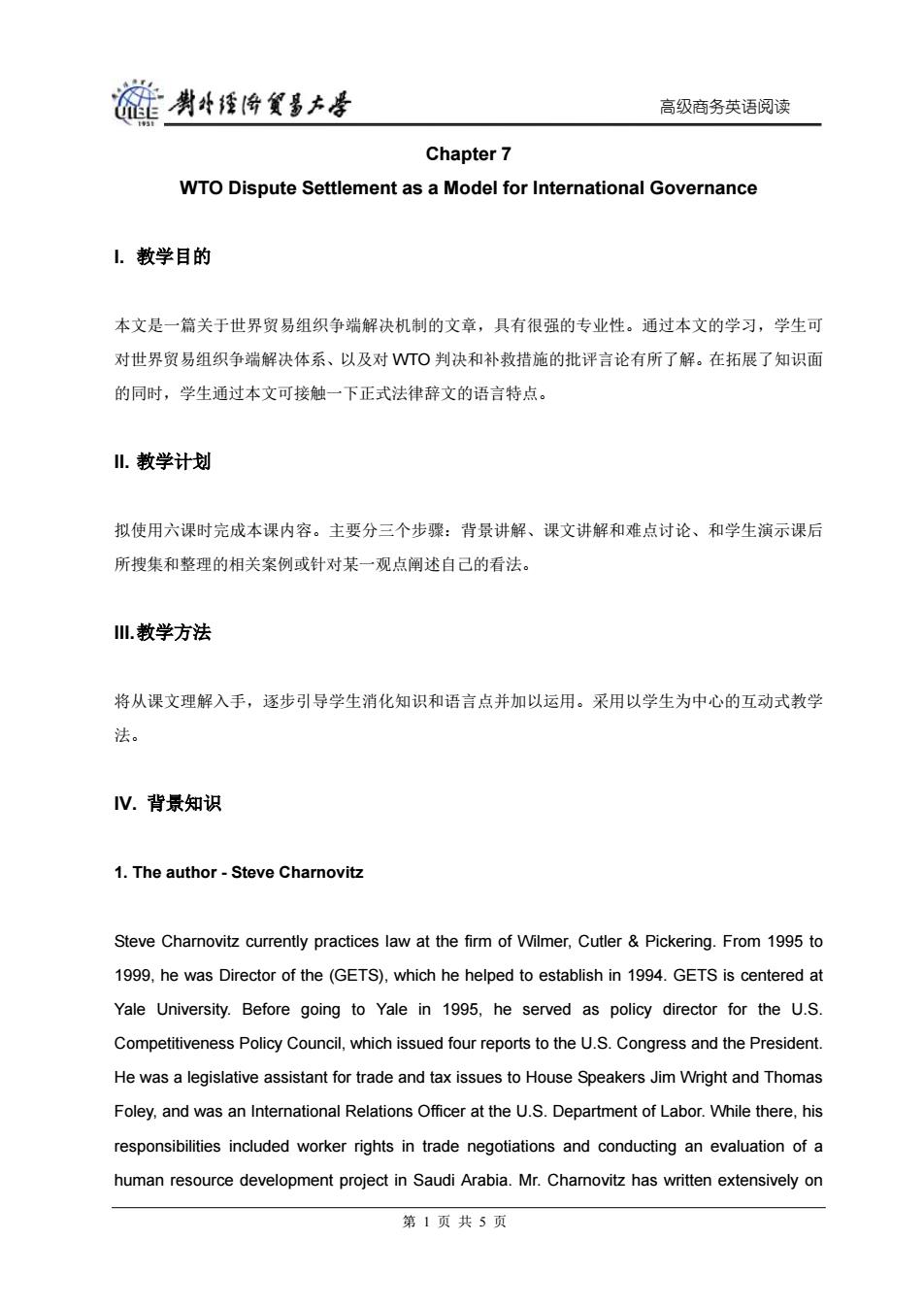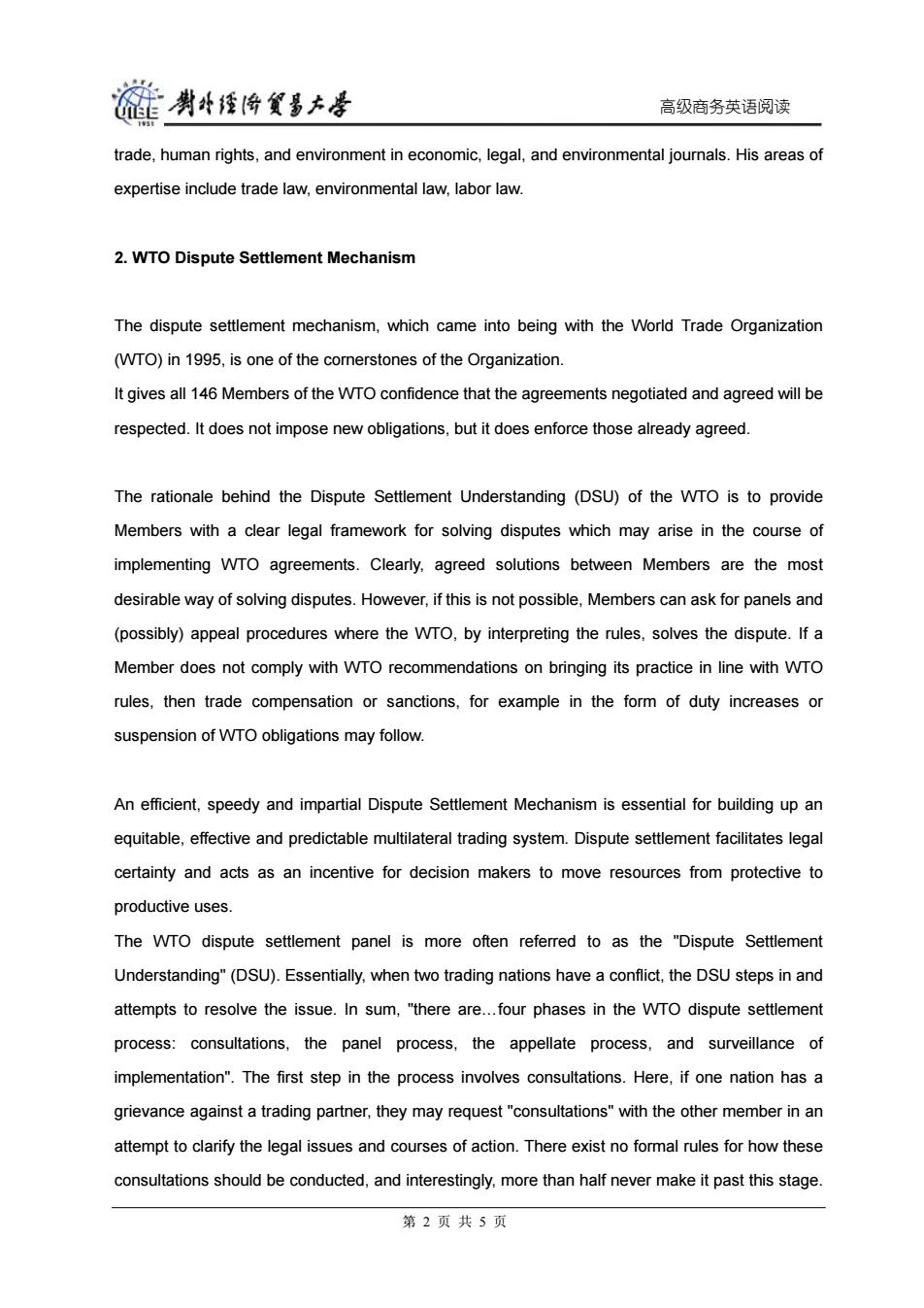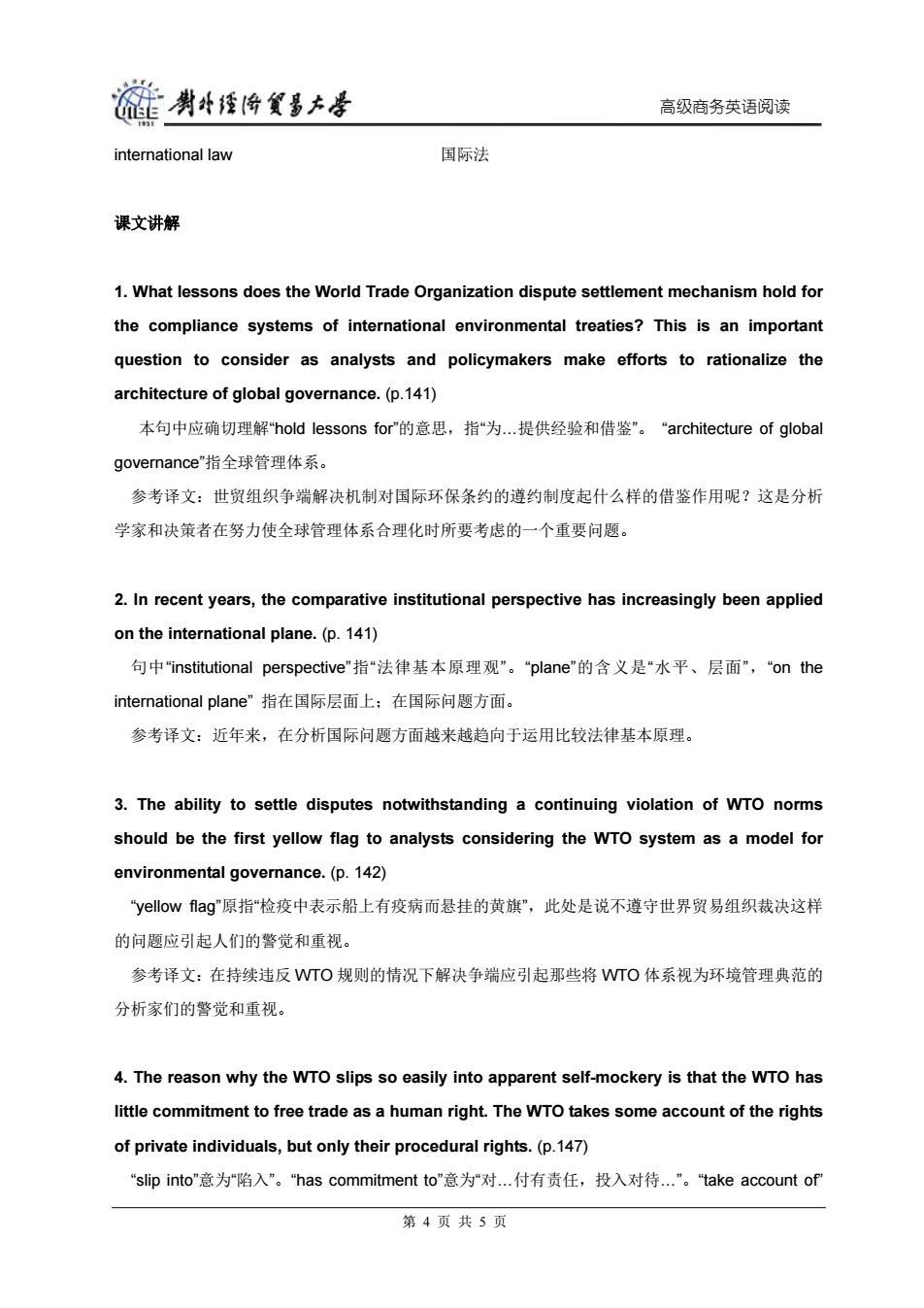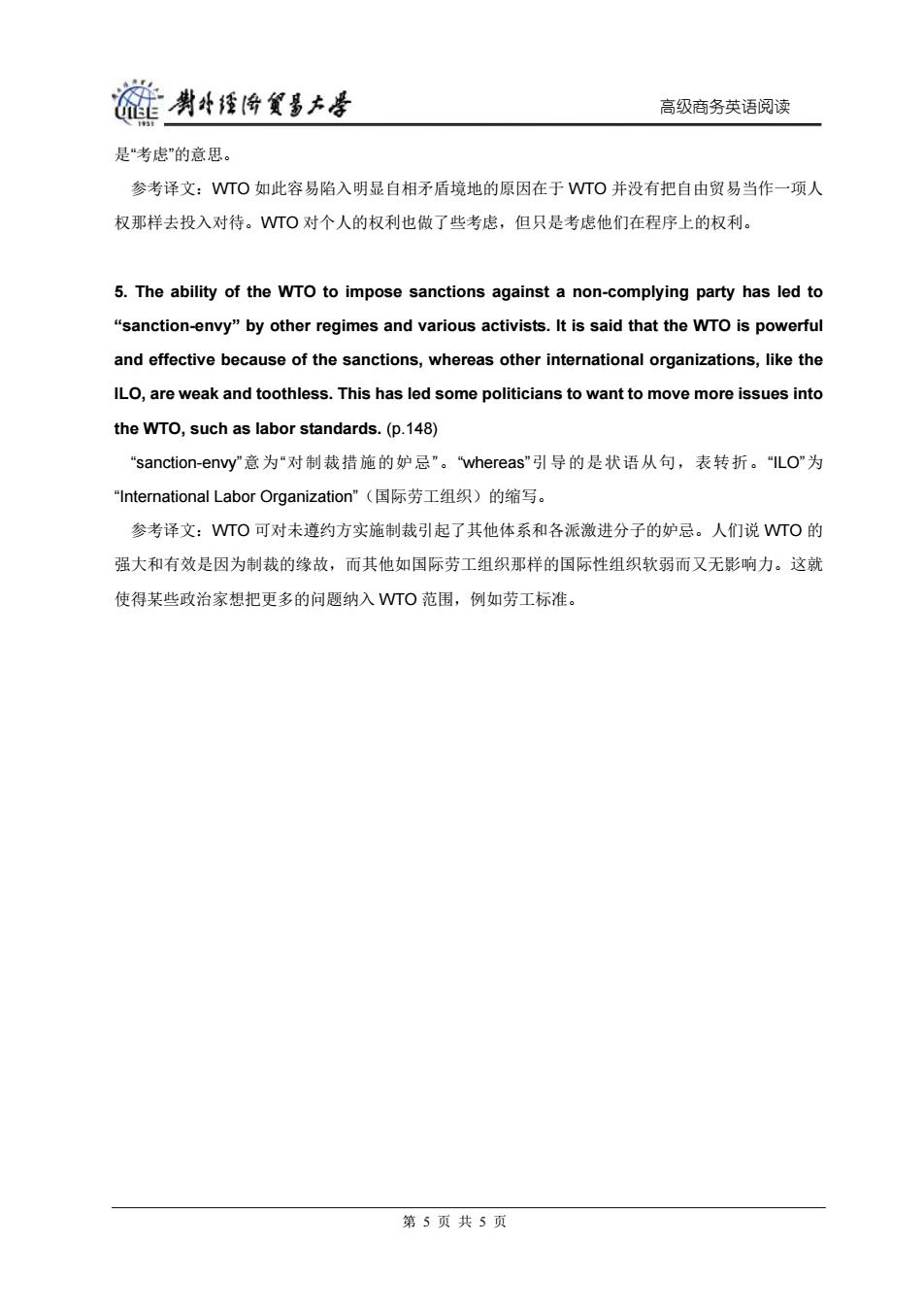
链喇外煙降餐多产学 高级商务英语阅读 Chapter 7 WTO Dispute Settlement as a Model for International Governance 1.教学目的 本文是一篇关于世界贸易组织争端解决机制的文章,具有很强的专业性。通过本文的学习,学生可 对世界贸易组织争端解决体系、以及对WTO判决和补救措施的批评言论有所了解。在拓展了知识面 的同时,学生通过本文可接触一下正式法律辞文的语言特点。 川.教学计划 拟使用六课时完成本课内容。主要分三个步骤:背景讲解、课文讲解和难点讨论、和学生演示课后 所搜集和整理的相关案例或针对某一观点阐述自己的看法。 l.教学方法 将从课文理解入手,逐步引导学生消化知识和语言点并加以运用。采用以学生为中心的互动式教学 法。 IV.背景知识 1.The author-Steve Charnovitz Steve Charnovitz currently practices law at the firm of Wilmer,Cutler Pickering.From 1995 to 1999,he was Director of the(GETS),which he helped to establish in 1994.GETS is centered at Yale University.Before going to Yale in 1995,he served as policy director for the U.S. Competitiveness Policy Council,which issued four reports to the U.S.Congress and the President. He was a legislative assistant for trade and tax issues to House Speakers Jim Wright and Thomas Foley,and was an International Relations Officer at the U.S.Department of Labor.While there,his responsibilities included worker rights in trade negotiations and conducting an evaluation of a human resource development project in Saudi Arabia.Mr.Chamnovitz has written extensively on 第1页共5页
高级商务英语阅读 Chapter 7 WTO Dispute Settlement as a Model for International Governance I. 教学目的 本文是一篇关于世界贸易组织争端解决机制的文章,具有很强的专业性。通过本文的学习,学生可 对世界贸易组织争端解决体系、以及对 WTO 判决和补救措施的批评言论有所了解。在拓展了知识面 的同时,学生通过本文可接触一下正式法律辞文的语言特点。 II. 教学计划 拟使用六课时完成本课内容。主要分三个步骤:背景讲解、课文讲解和难点讨论、和学生演示课后 所搜集和整理的相关案例或针对某一观点阐述自己的看法。 III. 教学方法 将从课文理解入手,逐步引导学生消化知识和语言点并加以运用。采用以学生为中心的互动式教学 法。 IV. 背景知识 1. The author - Steve Charnovitz Steve Charnovitz currently practices law at the firm of Wilmer, Cutler & Pickering. From 1995 to 1999, he was Director of the (GETS), which he helped to establish in 1994. GETS is centered at Yale University. Before going to Yale in 1995, he served as policy director for the U.S. Competitiveness Policy Council, which issued four reports to the U.S. Congress and the President. He was a legislative assistant for trade and tax issues to House Speakers Jim Wright and Thomas Foley, and was an International Relations Officer at the U.S. Department of Labor. While there, his responsibilities included worker rights in trade negotiations and conducting an evaluation of a human resource development project in Saudi Arabia. Mr. Charnovitz has written extensively on 第 1 页 共 5 页

剥牛煙将多大是 高级商务英语阅读 trade,human rights,and environment in economic,legal,and environmental journals.His areas of expertise include trade law,environmental law,labor law. 2.WTO Dispute Settlement Mechanism The dispute settlement mechanism,which came into being with the World Trade Organization (WTO)in 1995,is one of the cornerstones of the Organization. It gives all 146 Members of the WTO confidence that the agreements negotiated and agreed will be respected.It does not impose new obligations,but it does enforce those already agreed. The rationale behind the Dispute Settlement Understanding (DSU)of the WTO is to provide Members with a clear legal framework for solving disputes which may arise in the course of implementing WTO agreements.Clearly,agreed solutions between Members are the most desirable way of solving disputes.However,if this is not possible,Members can ask for panels and (possibly)appeal procedures where the WTO,by interpreting the rules,solves the dispute.If a Member does not comply with WTO recommendations on bringing its practice in line with WTO rules,then trade compensation or sanctions,for example in the form of duty increases or suspension of WTO obligations may follow. An efficient,speedy and impartial Dispute Settlement Mechanism is essential for building up an equitable,effective and predictable multilateral trading system.Dispute settlement facilitates legal certainty and acts as an incentive for decision makers to move resources from protective to productive uses. The WTO dispute settlement panel is more often referred to as the "Dispute Settlement Understanding"(DSU).Essentially,when two trading nations have a conflict,the DSU steps in and attempts to resolve the issue.In sum,"there are...four phases in the WTO dispute settlement process:consultations,the panel process,the appellate process,and surveillance of implementation".The first step in the process involves consultations.Here,if one nation has a grievance against a trading partner,they may request"consultations"with the other member in an attempt to clarify the legal issues and courses of action.There exist no formal rules for how these consultations should be conducted,and interestingly,more than half never make it past this stage. 第2页共5页
高级商务英语阅读 trade, human rights, and environment in economic, legal, and environmental journals. His areas of expertise include trade law, environmental law, labor law. 2. WTO Dispute Settlement Mechanism The dispute settlement mechanism, which came into being with the World Trade Organization (WTO) in 1995, is one of the cornerstones of the Organization. It gives all 146 Members of the WTO confidence that the agreements negotiated and agreed will be respected. It does not impose new obligations, but it does enforce those already agreed. The rationale behind the Dispute Settlement Understanding (DSU) of the WTO is to provide Members with a clear legal framework for solving disputes which may arise in the course of implementing WTO agreements. Clearly, agreed solutions between Members are the most desirable way of solving disputes. However, if this is not possible, Members can ask for panels and (possibly) appeal procedures where the WTO, by interpreting the rules, solves the dispute. If a Member does not comply with WTO recommendations on bringing its practice in line with WTO rules, then trade compensation or sanctions, for example in the form of duty increases or suspension of WTO obligations may follow. An efficient, speedy and impartial Dispute Settlement Mechanism is essential for building up an equitable, effective and predictable multilateral trading system. Dispute settlement facilitates legal certainty and acts as an incentive for decision makers to move resources from protective to productive uses. The WTO dispute settlement panel is more often referred to as the "Dispute Settlement Understanding" (DSU). Essentially, when two trading nations have a conflict, the DSU steps in and attempts to resolve the issue. In sum, "there are…four phases in the WTO dispute settlement process: consultations, the panel process, the appellate process, and surveillance of implementation". The first step in the process involves consultations. Here, if one nation has a grievance against a trading partner, they may request "consultations" with the other member in an attempt to clarify the legal issues and courses of action. There exist no formal rules for how these consultations should be conducted, and interestingly, more than half never make it past this stage. 第 2 页 共 5 页

碰男降贸多大是 高级商务英语阅读 In other words,the two countries,on their own,come to a mutually acceptable arrangement. Next,if the complaint is not dealt with in sixty days,the disgruntled country may request the establishment of a panel to rule on the matter.Three panelists must be selected,and because each country involved may object to any panelist,the process often takes about seven weeks. Furthermore,the panelists should not take advice from any outside member,and should remain impartial throughout the proceedings.The panel must "make an objective assessment of the matter before it...[in]conformity with the relevant WTO agreements".Complaints are officially filed to the panel,and two meetings are held to discuss the facts.The panel then composes a report summarizing the arguments and presenting its findings and recommendations.This should be done within nine months of the panel's establishment.Finally,the report becomes adopted as long as one member desires it,a significant change from the GATT dispute settlement system,which allowed one dissatisfied party to block a report. The final stage of the DSU process involves surveillance of implementation.Basically,a board attempts to ensure that the offending member has complied with the final panel report.If they do not,the board gives them instructions to do so,within a 30-day period after the initial finding.If the member refuses to comply,a last resort involves suspending that member's concessions.This has only happened twice since the beginning of the DSU. V.重点讲解 概念讲解 dispute settlement mechanism 争端解决机制 complaining government 原告政府 defendant government 被告政府 trade compensation 贸易赔偿 trade retaliation 贸易报复 international tribunal 国际法庭 trade sanction 贸易制裁 trade reciprocity 贸易互惠 第3页共5页
高级商务英语阅读 In other words, the two countries, on their own, come to a mutually acceptable arrangement. Next, if the complaint is not dealt with in sixty days, the disgruntled country may request the establishment of a panel to rule on the matter. Three panelists must be selected, and because each country involved may object to any panelist, the process often takes about seven weeks. Furthermore, the panelists should not take advice from any outside member, and should remain impartial throughout the proceedings. The panel must "make an objective assessment of the matter before it…[in] conformity with the relevant WTO agreements". Complaints are officially filed to the panel, and two meetings are held to discuss the facts. The panel then composes a report summarizing the arguments and presenting its findings and recommendations. This should be done within nine months of the panel’s establishment. Finally, the report becomes adopted as long as one member desires it, a significant change from the GATT dispute settlement system, which allowed one dissatisfied party to block a report. The final stage of the DSU process involves surveillance of implementation. Basically, a board attempts to ensure that the offending member has complied with the final panel report. If they do not, the board gives them instructions to do so, within a 30-day period after the initial finding. If the member refuses to comply, a last resort involves suspending that member’s concessions. This has only happened twice since the beginning of the DSU. V. 重点讲解 概念讲解 dispute settlement mechanism 争端解决机制 complaining government 原告政府 defendant government 被告政府 trade compensation 贸易赔偿 trade retaliation 贸易报复 international tribunal 国际法庭 trade sanction 贸易制裁 trade reciprocity 贸易互惠 第 3 页 共 5 页

碰男经降贸多大是 高级商务英语阅读 international law 国际法 课文讲解 1.What lessons does the World Trade Organization dispute settlement mechanism hold for the compliance systems of international environmental treaties?This is an important question to consider as analysts and policymakers make efforts to rationalize the architecture of global governance.(p.141) 本句中应确切理解“hold lessons for'”的意思,指“为..提供经验和借鉴”。“architecture of global governance"指全球管理体系。 参考译文:世贸组织争端解决机制对国际环保条约的遵约制度起什么样的借鉴作用呢?这是分析 学家和决策者在努力使全球管理体系合理化时所要考虑的一个重要问题。 2.In recent years,the comparative institutional perspective has increasingly been applied on the international plane.(p.141) 句中“institutional perspective'”指“法律基本原理观”。“plane'”的含义是“水平、层面”,“on the international plane'”指在国际层面上:在国际问题方面。 参考译文:近年来,在分析国际问题方面越来越趋向于运用比较法律基本原理。 3.The ability to settle disputes notwithstanding a continuing violation of WTO norms should be the first yellow flag to analysts considering the WTO system as a model for environmental governance.(p.142) yellow flag”原指“检疫中表示船上有疫病而悬挂的黄旗”,此处是说不遵守世界贸易组织裁决这样 的问题应引起人们的警觉和重视。 参考译文:在持续违反WTO规则的情况下解决争端应引起那些将WTO体系视为环境管理典范的 分析家们的警觉和重视。 4.The reason why the WTO slips so easily into apparent self-mockery is that the WTO has little commitment to free trade as a human right.The WTO takes some account of the rights of private individuals,but only their procedural rights.(p.147) “slip into”意为“陷入”。“has commitment to”意为“对..付有责任,投入对待."。“take account of" 第4页共5页
高级商务英语阅读 international law 国际法 课文讲解 1. What lessons does the World Trade Organization dispute settlement mechanism hold for the compliance systems of international environmental treaties? This is an important question to consider as analysts and policymakers make efforts to rationalize the architecture of global governance. (p.141) 本句中应确切理解“hold lessons for”的意思,指“为…提供经验和借鉴”。 “architecture of global governance”指全球管理体系。 参考译文:世贸组织争端解决机制对国际环保条约的遵约制度起什么样的借鉴作用呢?这是分析 学家和决策者在努力使全球管理体系合理化时所要考虑的一个重要问题。 2. In recent years, the comparative institutional perspective has increasingly been applied on the international plane. (p. 141) 句中“institutional perspective”指“法律基本原理观”。“plane”的含义是“水平、层面”,“on the international plane” 指在国际层面上;在国际问题方面。 参考译文:近年来,在分析国际问题方面越来越趋向于运用比较法律基本原理。 3. The ability to settle disputes notwithstanding a continuing violation of WTO norms should be the first yellow flag to analysts considering the WTO system as a model for environmental governance. (p. 142) “yellow flag”原指“检疫中表示船上有疫病而悬挂的黄旗”,此处是说不遵守世界贸易组织裁决这样 的问题应引起人们的警觉和重视。 参考译文:在持续违反 WTO 规则的情况下解决争端应引起那些将 WTO 体系视为环境管理典范的 分析家们的警觉和重视。 4. The reason why the WTO slips so easily into apparent self-mockery is that the WTO has little commitment to free trade as a human right. The WTO takes some account of the rights of private individuals, but only their procedural rights. (p.147) “slip into”意为“陷入”。“has commitment to”意为“对…付有责任,投入对待…”。“take account of” 第 4 页 共 5 页

能男经哈贸多大是 高级商务英语阅读 是“考虑”的意思。 参考译文:WTO如此容易陷入明显自相矛盾境地的原因在于WTO并没有把自由贸易当作一项人 权那样去投入对待。WTO对个人的权利也做了些考虑,但只是考虑他们在程序上的权利。 5.The ability of the WTO to impose sanctions against a non-complying party has led to "sanction-envy"by other regimes and various activists.It is said that the WTO is powerful and effective because of the sanctions,whereas other international organizations,like the ILO,are weak and toothless.This has led some politicians to want to move more issues into the WTO,such as labor standards.(p.148) “sanction-.eny"意为“对制裁措施的妒忌”。whereas"引导的是状语从句,表转折。“LO”为 “International Labor Organization”(国际劳工组织)的缩写。 参考译文:WTO可对未遵约方实施制裁引起了其他体系和各派激进分子的妒忌。人们说WTO的 强大和有效是因为制裁的缘故,而其他如国际劳工组织那样的国际性组织软弱而又无影响力。这就 使得某些政治家想把更多的问题纳入WTO范围,例如劳工标准。 第5页共5页
高级商务英语阅读 是“考虑”的意思。 参考译文:WTO 如此容易陷入明显自相矛盾境地的原因在于 WTO 并没有把自由贸易当作一项人 权那样去投入对待。WTO 对个人的权利也做了些考虑,但只是考虑他们在程序上的权利。 5. The ability of the WTO to impose sanctions against a non-complying party has led to “sanction-envy” by other regimes and various activists. It is said that the WTO is powerful and effective because of the sanctions, whereas other international organizations, like the ILO, are weak and toothless. This has led some politicians to want to move more issues into the WTO, such as labor standards. (p.148) “sanction-envy”意为“对制裁措施的妒忌”。“whereas”引导的是状语从句,表转折。“ILO”为 “International Labor Organization”(国际劳工组织)的缩写。 参考译文:WTO 可对未遵约方实施制裁引起了其他体系和各派激进分子的妒忌。人们说 WTO 的 强大和有效是因为制裁的缘故,而其他如国际劳工组织那样的国际性组织软弱而又无影响力。这就 使得某些政治家想把更多的问题纳入 WTO 范围,例如劳工标准。 第 5 页 共 5 页